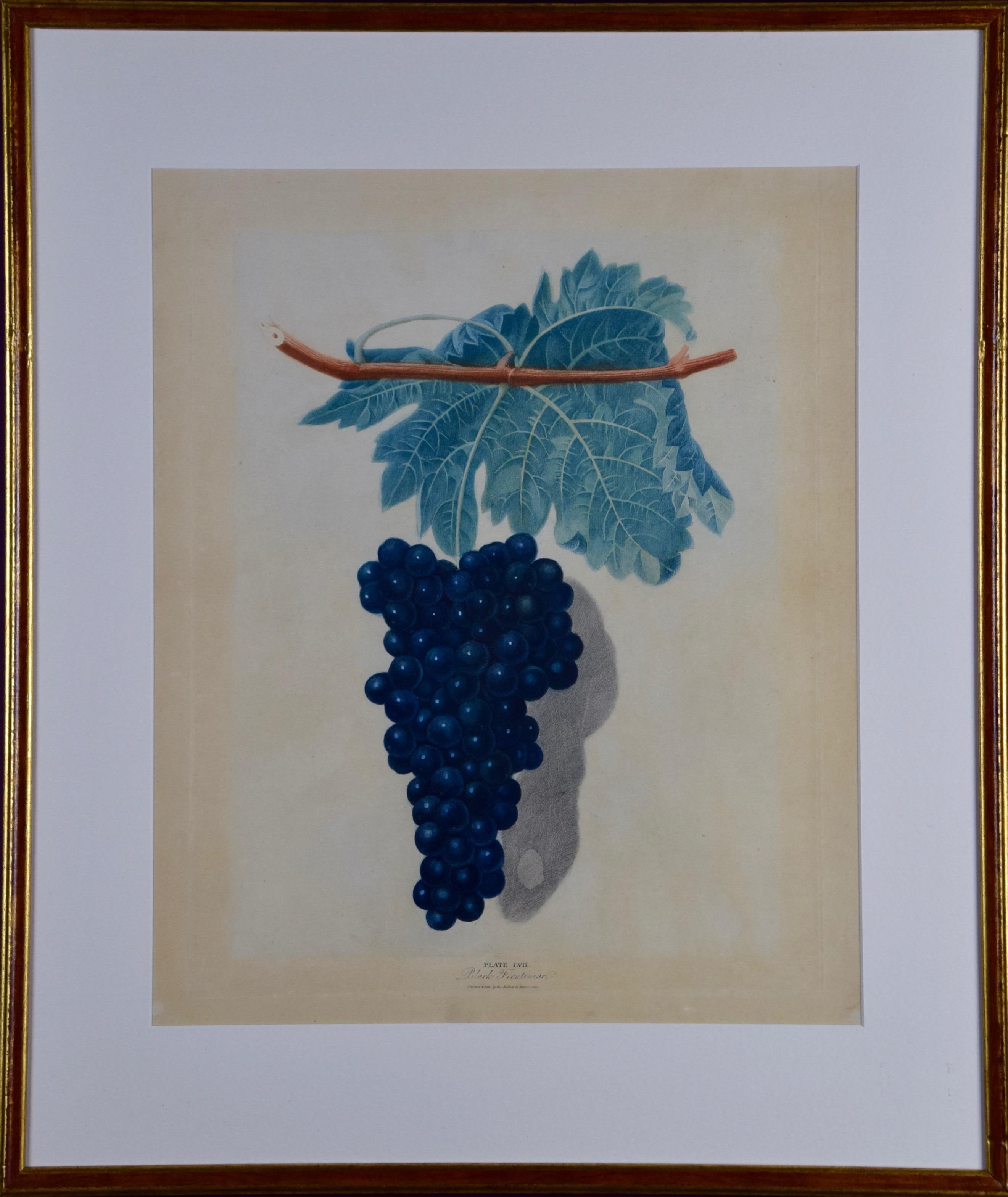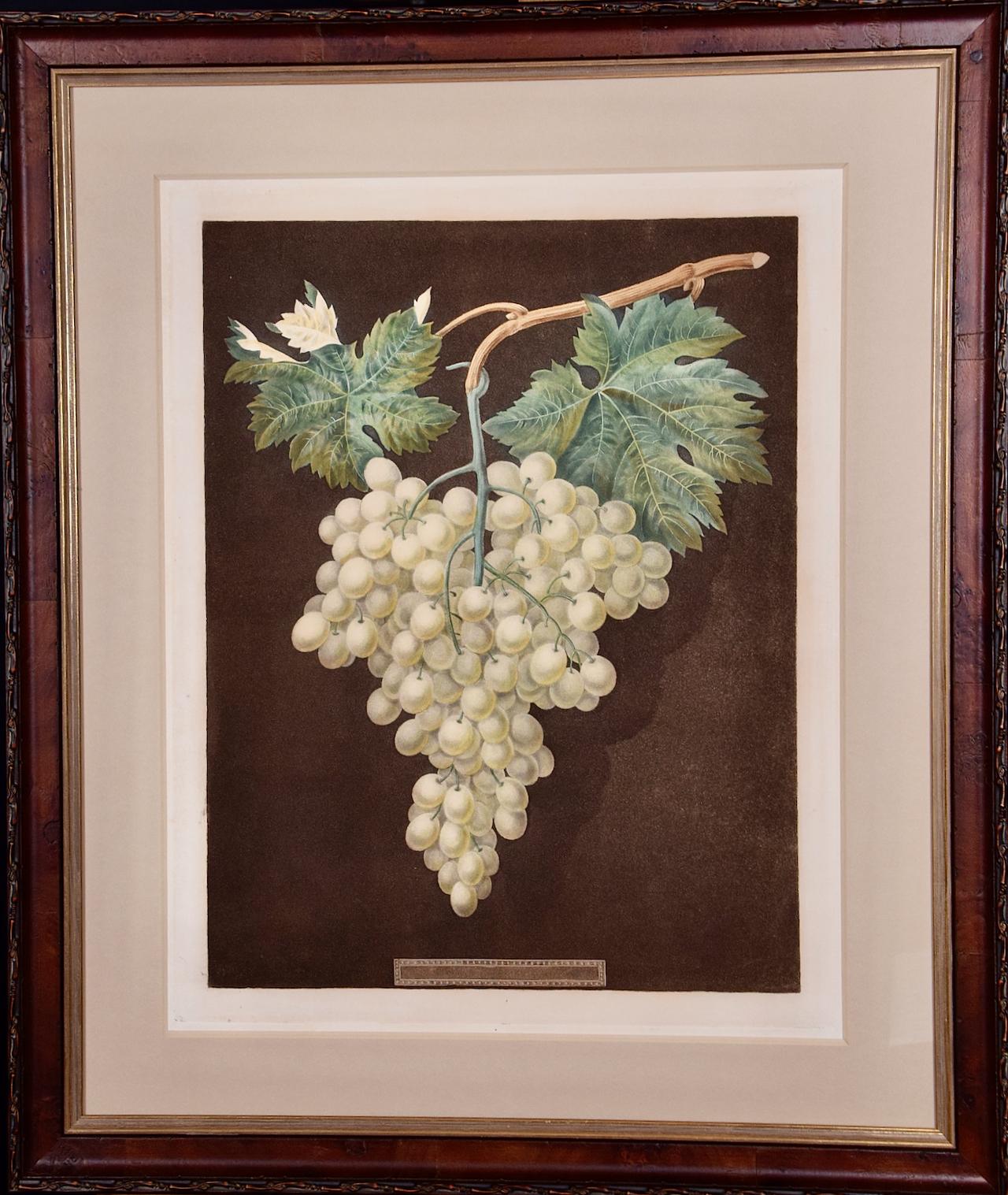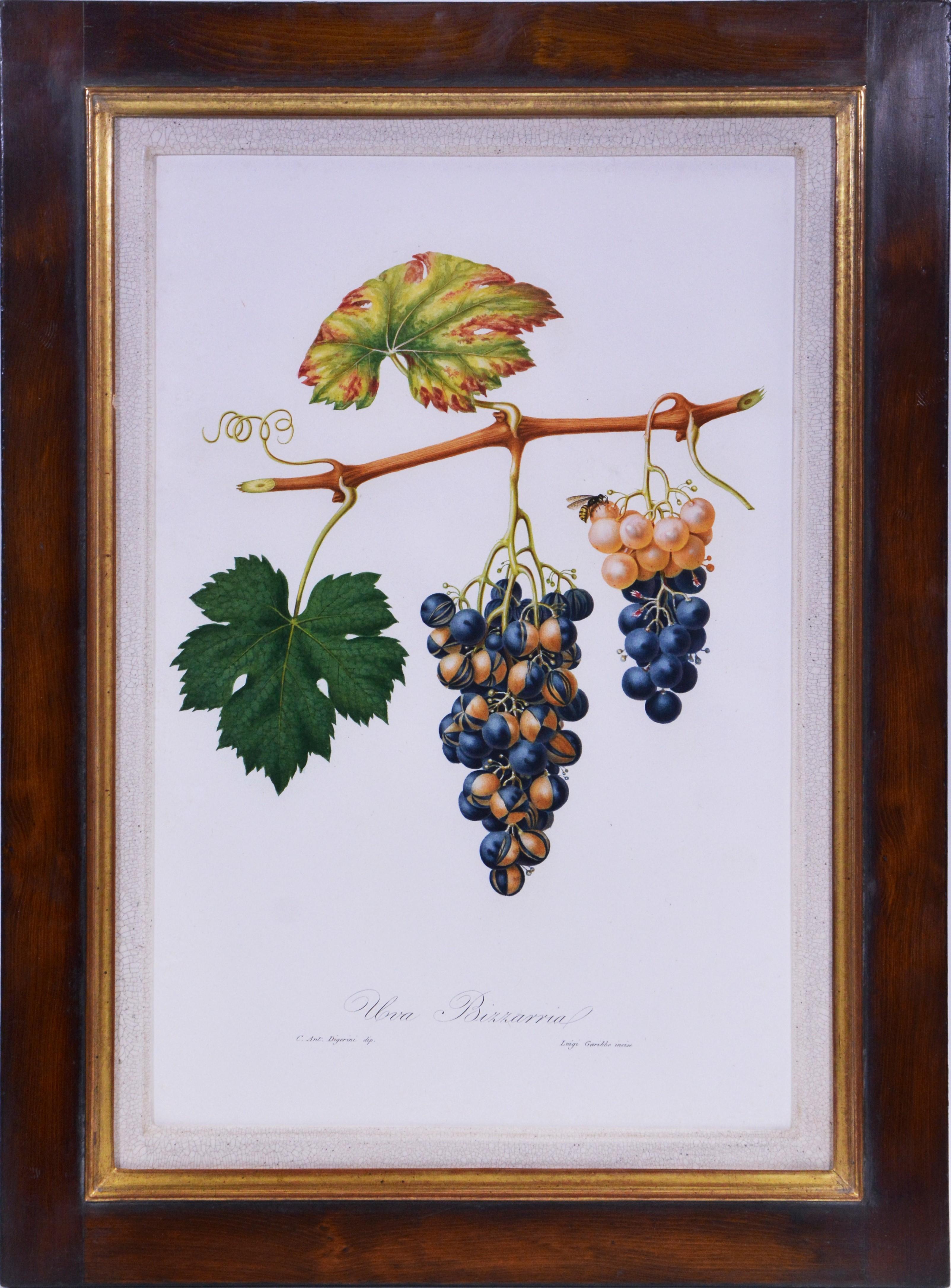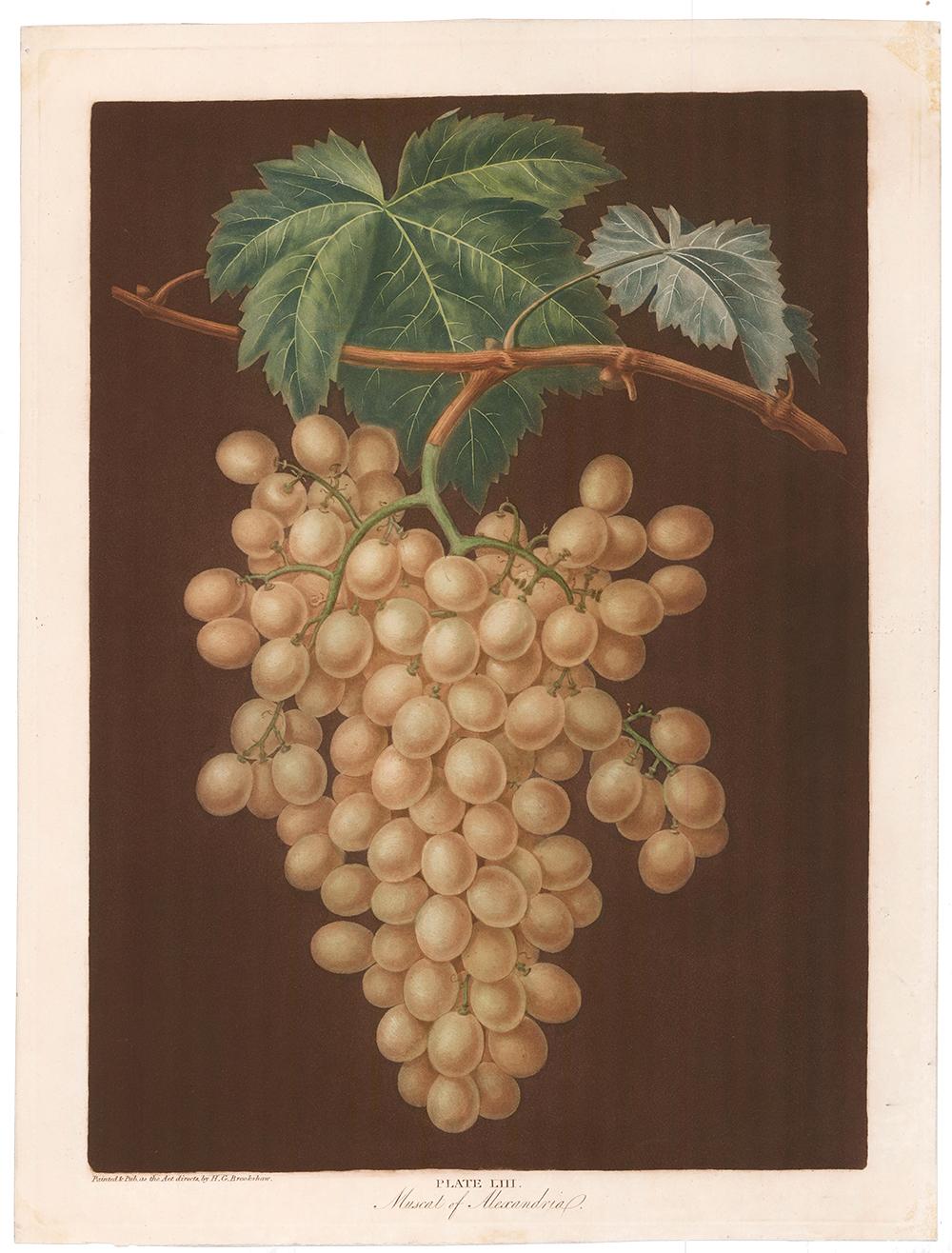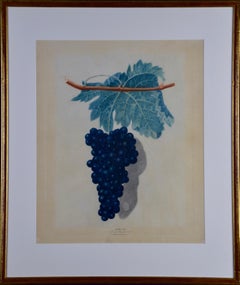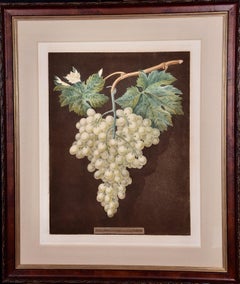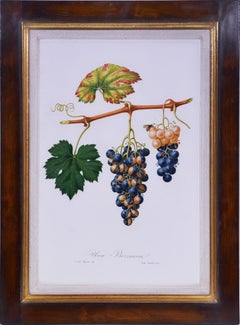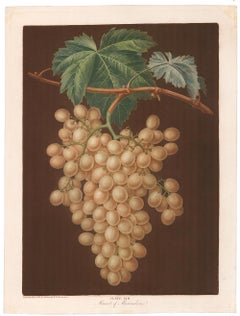Items Similar to George Brookshaw (1751-1823), Blue Muscadine Grape, PL XXXVIII
Want more images or videos?
Request additional images or videos from the seller
1 of 8
George Brookshaw George Brookshaw (1751-1823), Blue Muscadine Grape, PL XXXVIII
$1,200
£905.61
€1,036.78
CA$1,692.40
A$1,858.04
CHF 969.34
MX$22,484.89
NOK 12,149.23
SEK 11,447.77
DKK 7,739.31
About the Item
Print Sz: 11 1/2"H x 9 1/2"W
Frame Sz: 19 1/4"H x 16 3/4"W
Publisher: Longman, Hurst, Rees, Orme & Brown
Plate XXXVIII
George Brookshaw, also known as G. Brown, was a notable English painter and illustrator from London. His early career was spent as a London cabinet-maker specializing in painted furniture, often with floral decorations. Brookshaw also published supplementary drawing manuals on fruit, flowers, and birds.
Pomona Britannicaa London
1804-1812
Engravings with original hand-coloring
George Brookshaw's splendid "Pomona Brittanica" is a masterpiece among 19th-century British flower books. The publication of the "Pomona" marked the re-emergence of the acclaimed artist into the public eye after a total disappearance of nearly a decade. Initially a cabinet-make specializing in painted furniture decorated with borders of flowers, Brookshaw appears to have abandoned this career at about the same time as he parted company with his wife and began living with Elizabeth Stanton, and under the assumed name of G. Brown (c.1794-1804). During this time he earned a living as a teacher of flower-painting and on the proceeds of his first painting manual "A New Treatise on Flower Painting", 1797. Characterized by the highest standards of production and artistic quality, the superb illustrations that Brookshaw drew and engraved for the "Pomona" remain perhaps the most sumptuous and distinctive of the early 19th century. This magnificent and stylistically unique work took Brookshaw nearly ten years to produce. Rivaled only by Dr. Robert Thornton's "Temple of Flora," Brookshaw's 'Pomona' is considered to be the finest British botanical work from a time when England dominated the field with a very large number of great books. Brookshaw's fine illustrations make excellent use of the rich, modulated tones that the aquatint process creates. The elegantly arranged and richly colored fruits emerge from deep brown backgrounds or float on a softly mottled light ground, creating a presence unlike that of any other botanical illustrations. Brookshaw asserts in the preface that the "Pomona Britannica" was an enduring work created for the enjoyment and edification of "succeeding generations."
About the Seller
4.8
Vetted Professional Seller
Every seller passes strict standards for authenticity and reliability
Established in 2000
1stDibs seller since 2019
131 sales on 1stDibs
Typical response time: 1 hour
- ShippingRetrieving quote...Shipping from: Bristol, CT
- Return Policy
Authenticity Guarantee
In the unlikely event there’s an issue with an item’s authenticity, contact us within 1 year for a full refund. DetailsMoney-Back Guarantee
If your item is not as described, is damaged in transit, or does not arrive, contact us within 7 days for a full refund. Details24-Hour Cancellation
You have a 24-hour grace period in which to reconsider your purchase, with no questions asked.Vetted Professional Sellers
Our world-class sellers must adhere to strict standards for service and quality, maintaining the integrity of our listings.Price-Match Guarantee
If you find that a seller listed the same item for a lower price elsewhere, we’ll match it.Trusted Global Delivery
Our best-in-class carrier network provides specialized shipping options worldwide, including custom delivery.More From This Seller
View AllGeorge Brookshaw (1751-1823), Fruit Cluster, PL XII
Located in Bristol, CT
Print Sz: 11 1/2"H x 9 1/2"W
Frame Sz: 19 1/4"H x 16 3/4"W
Publisher: Longman, Hurst, Rees, Orme & Brown
Plate XII
George Brookshaw, also known as G. Brown, was a notable English...
Category
Early 1800s Still-life Prints
Materials
Engraving
George Brookshaw (1751-1823), Cherry Cluster, PL V
Located in Bristol, CT
Print Sz: 11 1/2"H x 9 1/2"W
Frame Sz: 19 1/4"H x 16 3/4"W
Publisher: Longman, Hurst, Rees, Orme & Brown
Plate V
George Brookshaw, also known as G. Brown, was a notable English painter and illustrator from London. His early career was spent as a London cabinet-maker specializing in painted furniture, often with floral decorations. Brookshaw also published supplementary drawing manuals on fruit, flowers, and birds.
Pomona Britannicaa London
1804-1812
Engravings with original hand-coloring
George Brookshaw's splendid "Pomona Brittanica" is a masterpiece among 19th-century British flower books. The publication of the "Pomona" marked the re-emergence of the acclaimed artist into the public eye after a total disappearance of nearly a decade. Initially a cabinet-make specializing in painted furniture decorated with borders of flowers, Brookshaw appears to have abandoned this career at about the same time as he parted company with his wife and began living with Elizabeth Stanton, and under the assumed name of G. Brown (c.1794-1804). During this time he earned a living as a teacher of flower-painting and on the proceeds of his first painting manual "A New Treatise on Flower Painting", 1797. Characterized by the highest standards of production and artistic quality, the superb illustrations that Brookshaw drew and engraved for the "Pomona" remain perhaps the most sumptuous and distinctive of the early 19th century. This magnificent and stylistically unique work took Brookshaw nearly ten years to produce. Rivaled only by Dr. Robert Thornton...
Category
Early 1800s Still-life Prints
Materials
Engraving
George Brookshaw (1751-1823), Apple Cluster, PL LX
Located in Bristol, CT
Print Sz: 11 1/2"H x 9 1/2"W
Frame Sz: 19 1/4"H x 16 3/4"W
Publisher: Longman, Hurst, Rees, Orme & Brown
Plate LX
George Brookshaw, also known as G. Brown, was a notable English painter and illustrator from London. His early career was spent as a London cabinet-maker specializing in painted furniture, often with floral decorations. Brookshaw also published supplementary drawing manuals on fruit, flowers, and birds.
Pomona Britannicaa London
1804-1812
Engravings with original hand-coloring
George Brookshaw's splendid "Pomona Brittanica" is a masterpiece among 19th-century British flower books. The publication of the "Pomona" marked the re-emergence of the acclaimed artist into the public eye after a total disappearance of nearly a decade. Initially a cabinet-make specializing in painted furniture decorated with borders of flowers, Brookshaw appears to have abandoned this career at about the same time as he parted company with his wife and began living with Elizabeth Stanton, and under the assumed name of G. Brown (c.1794-1804). During this time he earned a living as a teacher of flower-painting and on the proceeds of his first painting manual "A New Treatise on Flower Painting", 1797. Characterized by the highest standards of production and artistic quality, the superb illustrations that Brookshaw drew and engraved for the "Pomona" remain perhaps the most sumptuous and distinctive of the early 19th century. This magnificent and stylistically unique work took Brookshaw nearly ten years to produce. Rivaled only by Dr. Robert Thornton...
Category
Early 1800s Still-life Prints
Materials
Engraving
George Brookshaw (1751-1823), Pear Cluster, PL XLIX
Located in Bristol, CT
Print Sz: 11 1/2"H x 9 1/2"W
Frame Sz: 19 1/4"H x 16 3/4"W
Publisher: Longman, Hurst, Rees, Orme & Brown
Plate XLIX
George Brookshaw, also known as G. Brown, was a notable Englis...
Category
Early 1800s Still-life Prints
Materials
Engraving
George Brookshaw (1751-1823), Black Apricot; Breda Apricot; Brussels Moor Park A
Located in Bristol, CT
Print Sz: 11 1/2"H x 9 1/2"W
Frame Sz: 19 1/4"H x 16 3/4"W
Publisher: Longman, Hurst, Rees, Orme & Brown
Plate XX
George Brookshaw, also known as G. Brown, was a notable English ...
Category
Early 1800s Still-life Prints
Materials
Engraving
Richard de Menocal Floral Vase Still Life w/ Butterfly Oil on Canvas
Located in Bristol, CT
Art Sz: 15 3/4"H x 8"W
Frame Sz: 24"H x 16"W
Robert M Kulicke, Inc. Framemakers NYC Label on Verso
Ex: D.D. Ryan (1928-2007) Collection
Richard de Menocal...
Category
20th Century Figurative Paintings
Materials
Oil
You May Also Like
George Brookshaw's Black Frontiniac Wine Grape Aquatint from "Pomona Brittanica"
By George Brookshaw
Located in Alamo, CA
George Brookshaw's (1751-1823) beautiful Black Frontiniac Wine Grape hand-colored aquatint engraving, plate XVII from his "Pomona Brittanica", considered to be the finest British botanical large format treatise of the 19th-century. His engravings were unique for their rich tones and colors, elegant compositions with the fruit seeming to float on a rich mottled background.
The print is presented in a gold and burgundy-colored wood frame and a light gray mat. The print is in very good condition.
Another Brookshaw engraving from his series of fruit illustrations is available on 1stdibs. It is framed and matted identically to this one. It can be viewed on our 1stdibs storefront by typing Timeless Intaglio...
Category
Early 19th Century Realist Figurative Prints
Materials
Aquatint
White Hamburgh Grape: A Framed 19th C. Color Engraving by George Brookshaw
By George Brookshaw
Located in Alamo, CA
This is a 19th century colored aquatint and stipple engraving finished by hand entitled "White Hamburgh Grape", drawn and engraved by George Brookshaw and published in London in 1812 as plate 60 in his 'Pomona Britannica; or, A Collection of the Most Esteemed Fruits'. It depicts a cluster of pale green grapes still on the vine. The vine and leaves are shown in attractive shades of green and brown. The plant lays on a brown textured background with shadows to impart 3-dimensionality. The scene is reminiscent of an engraving in an 18th century artistically stylized human anatomy atlas. There is a light brown title rectangle in the lower center which is blank, suggesting this may be a more rare preproduction proof. There are wide white margins.
This striking engraving is presented in a reddish brown decorative wood frame with a darker brown scroll-work outer trim and a gold-colored inner fillet and a thick light beige mat. The frame measures 26" high, 22" wide and 1.13" deep. It is glazed with UV conservation glass. There is a tiny spot in the lower margin on the left and another in the left margin. The print and frame are otherwise in excellent condition.
There is a second Brookshaw engraving that is framed in identical moulding, although a slightly different size and a different color mat. It depicts a Silver Rock Melon. The two prints would make a striking display pairing...
Category
Early 19th Century Naturalistic Still-life Prints
Materials
Engraving, Aquatint
GALLESIO. A Group of Six Grapes.
Located in London, GB
Six hand-coloured plates of Grapes, printed in colour and finished by hand. Framed and glazed, overall size: 42.5 by 57.5cm. Pomona Italiana Ossia Trattato Degli Alberi Fruttiferi...
Category
1810s Naturalistic Still-life Prints
Materials
Handmade Paper, Engraving
Muscat of ALexandria Grapes by George Brookshaw
By George Brookshaw
Located in New York, NY
Plate LIII, Muscat of Alexandria. from "Pomona Britannica..." by George Brookshaw. London, T. Bensley for the author, 1804-1812. Original aquatint with stipple engraving, color pri...
Category
Early 19th Century Prints and Multiples
Materials
Paper
Black Frontiniac Grapes by George Brookshaw
By George Brookshaw
Located in New York, NY
Plate LVII, Black Frontiniac, from "Pomona Britannica..." by George Brookshaw. London, T. Bensley for the author, 1804-1812. Original aquatint with stipple engraving, color printed...
Category
Early 19th Century Prints and Multiples
Materials
Paper
FINE 1860'S BOTANNICAL WATERCOLOUR DRAWING - ISABELLA GRAPES ON THE VINE
Located in Cirencester, Gloucestershire
Artist/ School: English/ American School, 19th century, circa 1860's.
Title: Isabella Grapes on the vine. Interesting inscription telling the history of the drawing and how the orig...
Category
Mid-19th Century Victorian Still-life Paintings
Materials
Watercolor
More Ways To Browse
Antique Engravings London
Antique Hurst
Hamaguchi Mezzotints
Hodo Nishimura
Inoue Kozo
Japanese Print Yokohama
Kenny Scharf Flores
Kerry Day
Lemon Engraving
Matthaus Merian The Elder
Andy Warhol Skull
Andy Warhol Space Fruit
Christo Bottle
Georgia O Keeffe Flowers
Henri De La Pensee
Nicholas Robert Print
Pierre Pivet
Raoul Dufy Scarf
